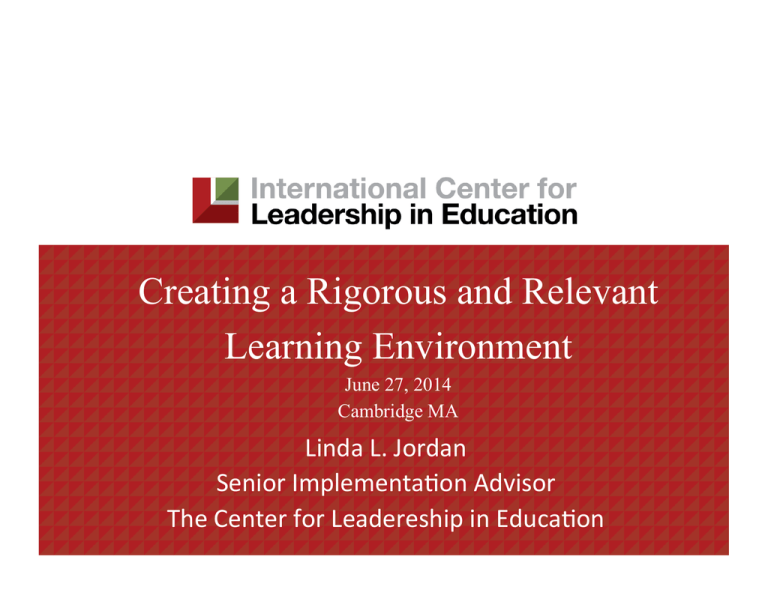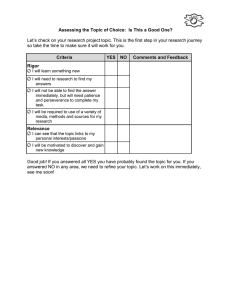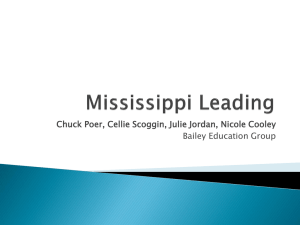Creating a Rigorous and Relevant Learning Environment
advertisement

Creating a Rigorous and Relevant Learning Environment June 27, 2014 Cambridge MA Linda L. Jordan Senior Implementa2on Advisor The Center for Leadereship in Educa2on Agenda Welcome & Intriductions Closing Relevance Relationships Rigor Learning Outcomes Understand how rigor, relevance and relationships support effective instruction Build awareness of tools aligned with the four quadrants of the Rigor/Relevance Framework Holland, Michigan 4 My Creden9als Senior Implementation Advisor The International Center for Leadership in Education Building Relationships Why do we need to get to know the teacher? (Linda) Emotion is the gatekeeper to learning Relationship is a key element in every classroom Builds trust Find common threads of interest Fun Building Rela9onships All We Have In Common With the people sitting near you form a group of 3-5 Create a list of at least three things you have in common. Be ready to share some items from you list with the group. 8 Educa9on Today College and Career Ready Teacher Evaluation Standards: Common Core and State Assessments: NGA and State Technology Defining College and Career Ready College/Career Ready Companies becoming paperless At home offices New Demands on Educators What will our students need to: know? do ? 13 How to Meet the New Demands DaggeK System for Effec9ve Instruc9on Daggett System for Effective Instruction Organizational Leadership Create a shared vision and culture for success; organizational systems aligned to support student achievement. Instructional Leadership Define instructional priorities, using data in a systematic way to drive decision making; ongoing opportunities provided for professional growth. Teaching Convey a deep knowledge of content and be equipped with a set of powerful teaching strategies to drive student achievement. ® Rigor/Relevance Framework A Focus on Relationships Teacher Student Student Student Neuroscience Connections The human brain is hardwired to give and receive care. Relationships Make Relevance Possible Relationships... -increase feelings of safety, motivation and risk-taking -can enhance learning -need to be in place to build the safety need to use higher order thinking (rigor) ShiP in Teaching Management-based Teaching Relationship-based Teaching Rules Mandated Negotiated Power Without question Authority with respect Indicators Students are passive and quiet Discouraged Students are actively engaged Encouraged Negotiate feed back/ punishment Positive reinforcement/ reward Disseminate knowledge Guide learning and give encouragement Risk-taking Control Mechanisms Teacher Role 22 • Page 250 The Daggett System for Effective Instruction How do you build rela9onships? What is the culture of your schools? • Bus drop-off/pick-up • Café • Hallways • Office 23 Rela9onship Resources Search the following keywords: • Teambuilding • Inclusion Activities • Energizers Focusing on Rigor How Do You Define Rigor? What makes a lesson rigorous for students? Defini2on Aspects of a Rigorous Lesson RIGOR Examples Non-­‐ examples Rigor Makes the Future Possible Rigor is… Rigor is NOT… ! Scaffolding thinking ! More or harder ! Planning for thinking worksheets ! AP or honors courses ! The higher level book in reading ! More work ! More homework ! Assessing thinking about content ! Recognizing the level of thinking students demonstrate ! Managing the teaching/ learning level for the desired thinking level 28 RIGOR MEANS FRAMING LESSONS AT THE HIGH END OF THE • KNOWLEDGE TAXONOMY. EVALUATION SYNTHESIS ANALYSIS APPLICATION COMPREHENSION KNOWLEDGE Bloom’s Taxonomy • Eval • Creating Synthesis Evaluatin g Analysis Analyzing Application Applying Comprehension Understanding Knowledge Remembering Original Revised Integrating Technology Bloom’s Taxonomy—Technology Version • educationaltechnologyguy.blogspot.com Rigorous Lessons ask Students to: EXAMINE PRODUCE CLASSIFY DEDUCE GENERATE ASSESS CREATE PRIORITIZE SCRUTINIZE DECIDE 32 Examining the Level of Knowledge 1. Look up definition of word of the day. 2. Write an explanatory essay about your interest in a particular career. 3. Discuss role of media in a democracy. 4. Make observations of similarities and differences between two search engines. 5. Order fractions from least to greatest on a number line. 6. On a model label the layers of Earth’s atmosphere. 7. Use the illustrations along with textual details from a text to describe the key idea. H or L Focusing on Relevance How Do You Define Relevance? What makes a lesson relevant for students? Defini2on Aspects of a Relevant Lesson RELEVANCE Examples Non-­‐ examples ® Rigor/Relevance Framework 36 Relevant Real World Application in Unanticipated Situations A Relevant Lesson asks Students to: USE THEIR KNOWLEDGE TO TACKLE REAL-WORLD PROBLEMS THAT HAVE MORE THAN ONE SOLUTION 38 RELEVANCE IS THE PURPOSE OF THE LEARNING: ACQUIRE KNOWLEDGE APPLY KNOWLEDGE INTERDISCIPLINARY REAL WORLD PREDICTABLE REAL WORLD UNPREDICTABLE What is Relevant to TODAY’s Students? K- Born in 2009 6th Grade- Born in 2002 12th Grade-Born in 1996 (in K 2001) What have you experienced that they have NOT? Adding Relevance to Any Lesson or Unit Comparing Learning to… • Student’s life • Family’s life • Student’s community and friends • Our world, nation, state • World of Work • World of Service • World of Business and Commerce that we interact with Use the Real World • Moral, ethical, political, cultural points of view, and dilemmas • Real world materials • Internet resources • Video and other media • Scenarios, real life stories • News - periodicals, media Rigor/Relevance Framework Tools to Support a Rigorous and Relevant Learning Environment Verb List by Quadrant Products by Quadrant A definition worksheet list quiz test workbook true-false reproduction recitation B scrapbook summary interpretation collection annotation explanation solution demonstration outline C essay abstract blueprint inventory report plan chart investigation questionnaire classification D evaluation newspaper estimation trial editorial play collage machine adaptation poem debate new game invention 45 Ques9ons By Quadrant C How are these similar/different? How is this like…? What’s another way we could say/explain/express that? What do you think are some reasons/causes? Why did…..changes occur? What is a better solution to…? How would you defend your position about that? _____________________________________________ A What is/are…? How many…? How do/does…? What did you observe…? What else can you tell me about…? What does it mean…? What can you recall…? Where did you find that…? Who is/are…? How would you define that in your own terms? D How would you design a…to …? How would you compose a song about…? How would you rewrite the ending to the story? What would be different today, if that event occurred as…? Can you see a possible solution to…? How could you teach that to others? If you had access to all the resources, how would you deal with…? What new and unusual uses would you create for…? ___________________________________________ B Would you do that? Where will you use that knowledge? How does that relate to your experience? What observations relate to…? Where would you locate that information? Calculate that for…? How would you illustrate that? How would you interpret that? How would you collect that data? How do you know it works? Application Model Decision Tree Instructional Strategies and the Rigor/Relevance Framework Artistic expression Brainstorming Compare and contrast Cooperative learning Demonstration Digital media production Feedback and reflection Game Guided practice Inquiry Instructional technology — any time Instructional technology — real time Instructional technology — independent learning Learning center Lecture Logical and independent thinking Manipulatives and models Memorization Note-taking/graphic Physical movement Play Presentation/exhibition Problem-based learning Project design Research Service learning Simulation/role playing Socratic seminar Storytelling Summarizing Teacher questions Teaching others Test preparation Video Work-based learning Writing to learn © International Center for Leadership in Education Quadrant A Acquisition Quadrant B Application Quadrant C Assimilation Quadrant D Adaptation (( (( (( (( ( (( (( ((( ((( ( (( (( (( ((( ((( (( ((( ((( (( (( ( ( (( ( (( ( (( ( (( (( (( (( ((( (( (( (( (( ( ( ((( ((( ((( (( (( (( (( (( ((( ((( ((( ( (( ((( (( (( ((( (( (( ((( ((( ( ((( ((( ( ((( (( ( ((( (( ((( ((( (( ((( ((( ((( (( ( (( ((( ( (( ((( ((( (( ((( (( (( ((( ((( (( (( (( ((( (( (( ( ((( (( (( ((( ((( ((( ((( (( ( (( 44 (( ((( ((( ((( (( ((( (( ((( ((( ( ( ((( ((( (( ((( (( ( ((( (( ( (( (( ((( ((( ((( ((( ((( ((( ((( ((( ((( (( ((( ((( ( (( ((( ((( Interna9onal Center for Leadership in Educa9on http://www.leadered.com 50 ® Rigor/Relevance Framework If You Understand You Are Responsible Linda L. Jordan ljordan@leadered.com 518-703-0114 ICLE 518-399-2776 www.leadered.com


